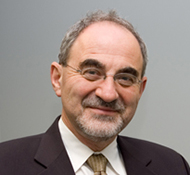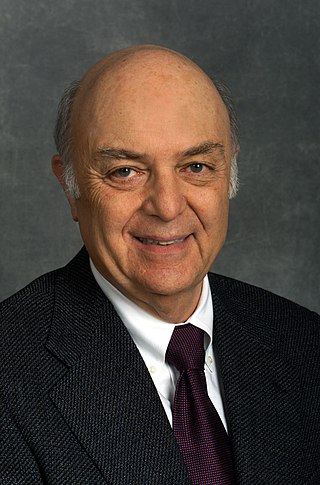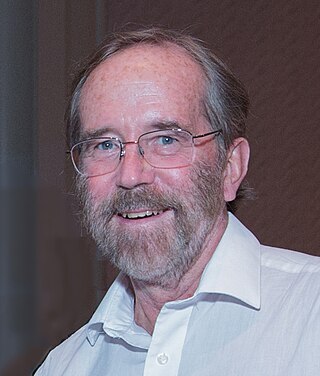Related Research Articles

Ion implantation is a low-temperature process by which ions of one element are accelerated into a solid target, thereby changing the physical, chemical, or electrical properties of the target. Ion implantation is used in semiconductor device fabrication and in metal finishing, as well as in materials science research. The ions can alter the elemental composition of the target if they stop and remain in the target. Ion implantation also causes chemical and physical changes when the ions impinge on the target at high energy. The crystal structure of the target can be damaged or even destroyed by the energetic collision cascades, and ions of sufficiently high energy can cause nuclear transmutation.

Reona Esaki, also known as Leo Esaki, is a Japanese physicist who shared the Nobel Prize in Physics in 1973 with Ivar Giaever and Brian David Josephson for his work in electron tunneling in semiconductor materials which finally led to his invention of the Esaki diode, which exploited that phenomenon. This research was done when he was with Tokyo Tsushin Kogyo. He has also contributed in being a pioneer of the semiconductor superlattices.

Eli Yablonovitch is an American physicist and engineer who, along with Sajeev John, founded the field of photonic crystals in 1987. He and his team were the first to create a 3-dimensional structure that exhibited a full photonic bandgap, which has been named Yablonovite. In addition to pioneering photonic crystals, he was the first to recognize that a strained quantum-well laser has a significantly reduced threshold current compared to its unstrained counterpart. This is now employed in the majority of semiconductor lasers fabricated throughout the world. His seminal paper reporting inhibited spontaneous emission in photonic crystals is among the most highly cited papers in physics and engineering.
Federico Capasso is an applied physicist and is one of the inventors of the quantum cascade laser during his work at Bell Laboratories. He is currently on the faculty of Harvard University.
Haroon Ahmed FREng, is a British Pakistani scientist in specialising the fields of microelectronics and electrical engineering. He is Emeritus Professor of Microelectronics at the Cavendish Laboratory, the Physics Department of the University of Cambridge, Honorary Fellow of Corpus Christi College, Cambridge, and Fellow of the Royal Academy of Engineering.

Marvin Lou Cohen is an American–Canadian theoretical physicist. He is a physics professor at the University of California, Berkeley. Cohen is a leading expert in the field of condensed matter physics. He is widely known for his seminal work on the electronic structure of solids.

Esther Marley Conwell was a pioneering American chemist and physicist, best known for the Conwell-Weisskopf theory that describes how electrons travel through semiconductors, a breakthrough that helped revolutionize modern computing. During her life, she was described as one of the most important women in science.
Leonard Cutler (1928–2006), also known as Leonard S. Cutler, was a pioneer and authority on ultra-precise timekeeping devices and standards, and was well known for his work with quantum-mechanical effects. He was the co-inventor of the HP5060A Cesium Beam Clock, its successor the HP 5071A, and the two-frequency laser inferometer. He has also been praised for his crucial contributions to the design of the Allen Telescope Array.

David J. Lockwood is a Canadian physicist and researcher emeritus at the National Research Council of Canada (NRC). He is also an adjunct professor at the University of Windsor in Windsor, Ontario, editor of the journal Solid State Communications, editor of the Springer book series "Topics in Applied Physics", and secretary-treasurer of the Canadian Association of Physicists. Lockwood is a Fellow of the Royal Society of Canada, the American Physical Society, the Electrochemical Society, and the Institute of Physics.

John Northrop Shive was an American physicist and inventor. He made notable contributions in electronic engineering and solid-state physics during the early days of transistor development at Bell Laboratories. In particular, he produced experimental evidence that holes could diffuse through bulk germanium, and not just along the surface as previously thought. This paved the way from Bardeen and Brattain's point-contact transistor to Shockley's more-robust junction transistor. Shive is best known for inventing the phototransistor in 1948, and for the Shive wave machine in 1959.
Morton B. Panish is an American physical chemist who, with Izuo Hayashi, developed a room-temperature continuous wave semiconductor laser in 1970. For this achievement he shared the Kyoto Prize in Advanced Technology in 2001.
James W. Mayer was an applied physicist, who was active in the field of ion-solid interactions. His accomplishments played a critical role in the development of the solid-state particle detector; the field of ion beam analysis of materials, and the application of ion implantation to semiconductors.
James William Corbett was a solid-state physicist.
Ady Hershcovitch is a plasma physicist best known for his 1995 invention, the plasma window, which was later patented.. In the plasma window, a plasma separates air from a vacuum by preventing the air from rushing into the vacuum. This scientific development can facilitate non-vacuum ion material modification, manufacturing of superalloys, and high-quality non-vacuum electron-beam welding. The device has been compared to the force field in the Star Trek TV series. He is well known for his work in plasma physics at Brookhaven National Laboratory. He has over 80 publications and 15 patents.
Suresh Chand Jain was an Indian physicist and director of the Defence Research and Development Organization. Known for his research in solid state physics, Jain was an elected fellow of the Indian National Science Academy and National Academy of Sciences, India. In 1966, the Council of Scientific and Industrial Research, the apex agency of the Government of India for scientific research, awarded him the Shanti Swarup Bhatnagar Prize for Science and Technology, one of the highest Indian science awards for his contributions to physical sciences.
Jean-Pierre Leburton is the Gregory E. Stillman Professor of Electrical and Computer Engineering and professor of Physics at the University of Illinois at Urbana–Champaign. He is also a full-time faculty member in the Nanoelectronics and Nanomaterials group of the Beckman Institute for Advanced Science and Technology. He is known for his work on semiconductor theory and simulation, and on nanoscale quantum devices including quantum wires, quantum dots, and quantum wells. He studies and develops nanoscale materials with potential electronic and biological applications.

Igor Serafimovich Tashlykov was a Soviet and Belarusian physicist, who was awarded the Doctor of Physical and Mathematical Sciences degree (1989). He was a member of the Belarusian Physical Society (1995). He carried out research at the Research Institute of Applied Physical Problems (APP) of the Belarusian State University, the Belarusian State Technological University, the Maxim Tank Belarusian State Pedagogical University (BSPU).

Joseph "Joe" E. Greene, known in his professional writing as J. E. Greene was an American materials scientist, specializing in thin films, crystal growth, surface science, and advanced surface engineering. His research and scientific contributions in these areas have been described as "pioneering" and "seminal" and that his work "revolutionized the hard-coating industry".

Aristos Christou is an American engineer and scientist, academic professor and researcher. He is a Professor of Materials Science, Professor of Mechanical Engineering and Professor of Reliability Engineering at the University of Maryland.
David A. Hammer is the J. Carlton Ward, Jr. Professor of Nuclear Energy Engineering, in the Cornell University College of Engineering. In 2004, Hammer received the Institute of Electrical and Electronics Engineers Plasma Science and Applications Committee Award, as well as the Distinguished Career Award from Fusion Power Associates in 2018.
References
- ↑ "Leonard Feldman" . Retrieved April 27, 2017.
- ↑ "Leonard C. Feldman". rutgers.edu. Retrieved April 27, 2017.
- ↑ "2016 elevated fellow" (PDF). IEEE Fellows Directory. Archived from the original (PDF) on 2016-01-14. Retrieved 2019-09-10.